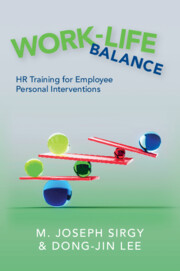Book contents
- Work-Life Balance
- Work-Life Balance
- Copyright page
- Contents
- Figures
- Tables
- Part I Making the Case for Work-Life Balance
- Part II Behavior-Based Personal Interventions of Work-Life Balance
- Chapter 4 Engaging in Multiple Roles and Domains
- Chapter 5 Increasing Role Enrichment
- Chapter 6 Engaging in Behavior-Based Compensation
- Chapter 7 Managing Role Conflict
- Chapter 8 Creating Role Balance
- Part III Cognition-Based Personal Interventions of Work-Life Balance
- Part IV Epilogue
- Index
- References
Chapter 4 - Engaging in Multiple Roles and Domains
from Part II - Behavior-Based Personal Interventions of Work-Life Balance
Published online by Cambridge University Press: 19 January 2023
- Work-Life Balance
- Work-Life Balance
- Copyright page
- Contents
- Figures
- Tables
- Part I Making the Case for Work-Life Balance
- Part II Behavior-Based Personal Interventions of Work-Life Balance
- Chapter 4 Engaging in Multiple Roles and Domains
- Chapter 5 Increasing Role Enrichment
- Chapter 6 Engaging in Behavior-Based Compensation
- Chapter 7 Managing Role Conflict
- Chapter 8 Creating Role Balance
- Part III Cognition-Based Personal Interventions of Work-Life Balance
- Part IV Epilogue
- Index
- References
Summary
This chapter covers the research focusing on how employees use a behavior-based personal intervention to balance their work life with other important life domains such as family life, social life, and leisure life. This personal intervention involves role engagement in multiple roles and domains. Role engagement can be implemented through (1) increasing role involvement in a manner consistent with life priorities, (2) engaging in multiple life domains to achieve positive balance, and (3) engaging in important roles with harmonious passion. We also discuss intervention programs that organizations can institutionalize to achieve higher levels of employee work-life balance through role engagement.
Keywords
- Type
- Chapter
- Information
- Work-Life BalanceHR Training for Employee Personal Interventions, pp. 41 - 53Publisher: Cambridge University PressPrint publication year: 2023



